“I believe these emerging news organizations are performing a valuable news service, reporting news I don’t see elsewhere, or reporting more deeply than our general-interest newspapers.”
– Bruce Koon | News Director, KQED Public Radio
KQED, the most-listened-to station in the San Francisco area, was the only public broadcaster to spearhead a Net-J partnership. News Director Bruce Koon saw it as a chance to test-drive “a new iteration” of a news and partnership model.
Unlike other Net-J projects, KQED’s News Associates would not only share links and content but they would also participate in news reports for radio.
“There are changes in media today that continue to make collaborations more complicated,” Koon told a J-Lab/Online News Association workshop in September 2012. “Partners are more than just link swaps. They have to be a partner contributing.”
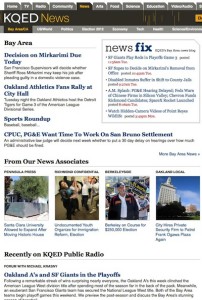 KQED launched its project with considerable press pickup on Aug. 10, 2011. At the same time, it announced it would share food-related content with HuffingtonPost San Francisco. By fall 2012, the number of partners had grown from five to eight and Koon regarded the collaboration as “successfully integrated into the daily work flow” of KQED News and KQEDNews.org. The project’s Community News Coordinators played a critical role.
KQED launched its project with considerable press pickup on Aug. 10, 2011. At the same time, it announced it would share food-related content with HuffingtonPost San Francisco. By fall 2012, the number of partners had grown from five to eight and Koon regarded the collaboration as “successfully integrated into the daily work flow” of KQED News and KQEDNews.org. The project’s Community News Coordinators played a critical role.
Here’s how it worked: Stories from partner sites automatically flow into KQED’s content management system via RSS feeds. The news coordinator reviews the stories and selects those to be featured on the station’s Bay Area news page and outside on the KQEDNews.org home page.
On both pages the selected stories flow into a so-called “queue,” a horizontal module that features a total of four stories with photos. A new story lands in the first spot on the module and the oldest story cycles off. On the home page, however, News Associate stories must compete for play with other KQED blogs and features.

The Community News Coordinators – initially Molly Samuel and now Katrina Swartz – have another important task. They select News Associate stories they will “pitch” to KQED news editors for on-air opportunities. Successful pitches lead to so-called “debriefs” where KQED news anchors interview reporters at the partner sites about their stories. The partners get identified and credited on the air for their participation and information. These on-air stories also get a link from KQED’s News Fix news blog.
KQED aired 62 reporter debriefs between May 2011 and mid-October 2012. This also meant, however, that partners that focused on newsy, daily stories were more frequently on the air.
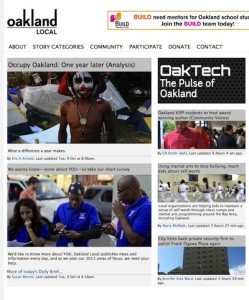 For instance, when Oakland’s police chief suddenly resigned, Jennifer Inez Ward of Oakland Local was debriefed on what happened. Since it became a partner, Oakland Local has participated in 25 on-air debriefs, founder Susan Mernit said.
For instance, when Oakland’s police chief suddenly resigned, Jennifer Inez Ward of Oakland Local was debriefed on what happened. Since it became a partner, Oakland Local has participated in 25 on-air debriefs, founder Susan Mernit said.
“KQED has great good will in the community,” Molly Samuel said. “The people we worked with were happy to have their names attached to ours.”
KQED picked its initial five partners from some 62 local sites. KQED aimed for partners that covered targeted geographic areas, had a journalistic mindset, updated regularly and were interested enough in collaboration that they would view the partnership as “more than a distribution agreement,” Koon said. KQED’s goal was to expand the public radio station’s offerings of breaking news or “good reads” to its nine-county regional audience. KQED also has a separate partnership with the Center for Investigative Reporting’s California Watch project.
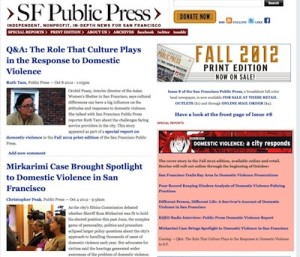 A central precept, he said, was: “What can we as partners do together than neither of us could do alone?”
A central precept, he said, was: “What can we as partners do together than neither of us could do alone?”
The initial five partners were Berkeleyside, as well as Oakland Local, which works with underserved communities in Oakland, CA; and NeighborWebSJ, an online news site for San Jose. (Both of these sites were launched with the help of J-Lab/New Voices seed funding). Later added were San Francisco Public Press, which covers public-interest news and publishes a quarterly print edition, and Ocean Beach Bulletin, which covers coastal development and other issues in this beachside community. Each got $4,000 stipends.
Also coming on board were Peninsula Press, a Stanford University student-reported site covering mid-Peninsula news; Richmond Confidential, which uses UC-Berkeley journalism students to cover Richmond, CA; and San Jose Beez, which is a collaboration of ethnic media outlets covering San Jose and the South Bay. KQED drafted a memo of understanding for the partners to sign.
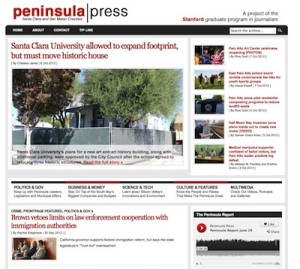
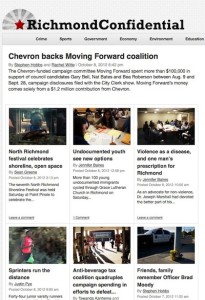
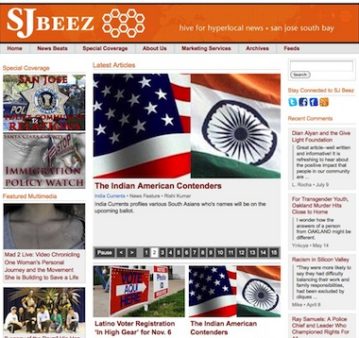
The news release announcing the launch got some cheers but also a little pushback from some commenters who criticized public radio for partnering with commercial media, as some of the initial partners were.
However, concerns about advocacy in media trumped concerns about commercial media and prompted KQED to make its News Associates criteria narrower than expected. “The question of local news organizations that don’t mind being viewed as advocates was more problematic than I anticipated,” Koon said. “And the issue was about more than just different definitions of what constitutes ‘news’.”
For instance, KQED had hoped to partner with StreetsBlog SF, a news site about the livable-cities movement that covers efforts to reduce the dependence on cars and improve conditions for pedestrians, cyclists and mass-transit riders.
But the station’s management wasn’t comfortable partnering with an advocacy site. As a public-radio station, KQED has different concerns than a commercial newspaper, Koon said. “We fall into fairness issues in the FTC guidelines. Also our nonprofit status puts us in a different frame of mind than a commercial newspaper, which can have a separate editorial board that does things like endorsements.”
KQED has had several training sessions for the News Associates. In an early session, the partners asked for more radio-broadcast training. So, they learned how to use iPhone apps, record interviews, get ambient sound – generally what makes for good radio. KQED also knew that links off its website to the partner sites might not drive significant traffic to its partners but airtime would. Koon noted that if the News Associates actually collect audio tape with their stories, KQED in the future could pay them as freelancers.
At a recent training in September 2012, about 30 participants from five different participating organizations learned how to compose and shoot good photos.
Oakland Local’s Mernit said the partnership has been great for her site. “We got a level of exposure and credibility that was very, very valuable to us.”
While the collaboration has primarily been one-way, with Oakland Local sending stories to KQED, it has turned into a “reciprocal” relationship, where the station will check to see what Oakland Local is planning to cover. “Ten percent of the time, we weren’t going to, but since you’re interested, we will,” Mernit tells them.
She also makes a point eliciting agreements in advance from her reporters, who get paid little or nothing, so that they are willing to participate in the KQED debriefs.
Koon cites several of his takeaways:
- Non-broadcast news organizations can work successfully with broadcast news organizations. The partnership, for instance, allowed KQED Public Radio to cover a story like Occupy Oakland more extensively, and in some cases the partner “was the main reporting source for us.”
- Partnerships require an editor. “We’re facing the daunting task of how to keep this going.” KQED was able to cobble enough support to hire Katrina Schwartz through September 2012 to replace Molly Samuel.
- Emerging news organizations continue to grow in the delivery of solid news with strong journalism values.
“I believe these emerging news organizations are performing a valuable news service, reporting news I don’t see elsewhere,” Koon said, “or reporting more deeply than our general-interest newspapers.”






